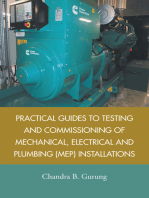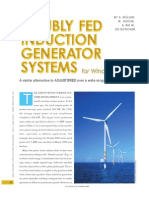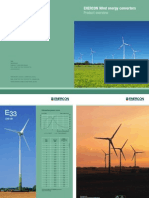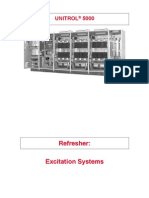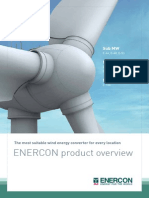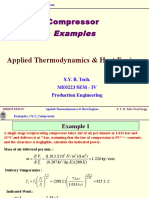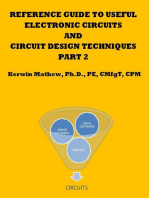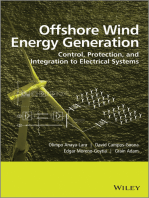A New Simpow Model DFIG - Doubly-Fed Induction Generator
Uploaded by
vakilgaurangi8709A New Simpow Model DFIG - Doubly-Fed Induction Generator
Uploaded by
vakilgaurangi87092005-11-30
A new Simpow model DFIG Doubly-fed Induction Generator
Developed by Bengt Frankn, STRI November 17, 2005 Ludvika, Sweden
Bengt Frankn 2005-11-17
The concept of the Doubly-fed Induction Generator
Gear Box Induction Generator
i sa i sb i sc
irNc
DC-link
irNa irNb
Grid
irc irb ira
VSC
VSC Control
Bengt Frankn 2005-11-17
2005-11-30
Aimed for transient studies of wind power,
Transta 3rd order model including rotor transients Single mass model Users give DFIG data and wind profile Flexibility to exchange any of the models
Wind turbine Pitch control model Speed control model Voltage control model Crow-bar protection model
Features
Bengt Frankn 2005-11-17
Step-up transformer outside of the DFIG model
3
Modules
U ac-node AC-node Peg Qeg Asynchronous machine Speed control Peg W Ps Qs Pr Qr Crow-bar control U ac-node
Rcbin
Pord
Qord
AC voltage control
U ac-node
TM W Pord W Y Wind turbine
Pitch control
Bengt Frankn 2005-11-17
W = rotation speed W = rotation speed deviation Pord = power order Peg = actual power
TM = mechanical torque Y = blade angle Qord = reactive power order Rcbin = crow-bar resistor in/out
2005-11-30
Data for DFIG model
Wind turbine data
Lengths of the blades Nominal angular speed Efficiency curves (Cp/-curve) for the blades and
different blade angles
Generator data
Sn, Rs, Xs, Xm, etc. Inertia constant, H, includes the mass of the wind
turbine Total Power/Rotor speed-curve given as: Wr = a*P2 + b*P + c
5
Bengt Frankn 2005-11-17
Efficiency curve (Cp/-curve)
Bengt Frankn 2005-11-17
Power Coefficient Cp with blade pitch angle (Y at slide #4) as a parameter.
6
2005-11-30
Total Power/Rotor speed-curve
1
Total power, Pg (p.u.)
0.8
Wr = a*P2 + b*P + c
0.6
0.4
0.2
0 0.6
0.7
0.8
0.9
1.1
1.2
1.3
Bengt Frankn 2005-11-17
Rotor speed (p.u.)
Simulation of Wind Variations
Used data of the 2 MW DFIG Wind turbine Generator (typical)
Blade lengths 36 m Blade weight 10 tonnes Nominal angular speed
1.88 rad/s, i.e., 18 rpm
Total power/Rotor speed
Wr = a*P2 + b*P + c a = -0.63 b=1.40 c=0.52
Bengt Frankn 2005-11-17
Rated power 2.05 MVA Rs = 0.01 pu Rr = 0.009 pu Xs = 0.18 pu Xr = 0.07 pu Xm = 4.4 R2 = 0.03 pu (3*Rs) X2 = 0.25 pu (Xs+Xr) H = 5.5 s (based on the heavy wind turbine)
8
2005-11-30
Simulation of Wind Variations
Bengt Frankn 2005-11-17
Wind speed in black starts at 9.3 m/s, goes up to 12.5 m/s and ends at 6.5 m/s Generated power in red starts at 0.49 pu, goes up to 0.99 pu and ends at 0.15 pu Rotation speed in blue starts at 1.04 pu, goes up to 1.30 pu and ends at 0.72 pu
9
Simulation of Wind Variations
Bengt Frankn 2005-11-17
Generated power in black starts at 0.49 pu, goes up to 0.99 pu and ends at 0.15 pu Stator real power in red starts at -0.47 pu and varies between -0.77 pu and -0.22 pu Rotor real power in blue starts at -0.02 pu and varies between -0.22 pu and +0.06 pu
10
2005-11-30
Simulation of Wind Variations
Bengt Frankn 2005-11-17
Consumed Mvar in black 0.0 pu as unity power factor control in rotor circuit Stator Mvar in red equal to consumed Mvar i.e. 0.0 pu Rotor Mvar in blue starts with 0.01 pu and varies between -0.11 pu and +0.07 pu
11
Simulation of Wind Variations
Bengt Frankn 2005-11-17
Efficiency Cp in black 0.5 pu as optimum and decrease to 0.41 pu at active pitch Mech. torque in red starts at 0.47 pu and is reduced at active pitch Blade angle in blue starts with 0 deg and increase to 4 deg at active pitch
12
2005-11-30
References
Andreas Petersson, Analysis, Modeling and Control of Doubly-fed Induction Generators for Wind Turbines, Ph.D. thesis, Chalmers University of Technology, Sweden, 2005. Florent Maupas, Impact of Voltage Control Equipment on the Network Integration of Large Offshore Wind Farms Interconnected with HVAC, Master thesis XETS/EES-0424, Department of Electrical Engineering, Royal Institute of Technology (KTH), Stockholm, Sweden, December, 2004. Vladislav Akhmatov, Analysis of Dynamic Behaviour of Electric Power Systems with Large Amount of Wind Power, Ph.D. thesis, Technical University of Denmark, Lyngby, Denmark, April, 2003. Francesco Sulla, Modeling of Asynchronous Machines in Simpow, ABB TR H 03-168, Master thesis, ABB Utilities, Vsters, Sweden. Also available as B-EES-0301, Department of Electrical Engineering, Royal Institute of Technology (KTH), Stockholm, Sweden, March, 2003.
Bengt Frankn 2005-11-17
13
Bengt Frankn 2005-11-17
14
You might also like
- Practical Guides to Testing and Commissioning of Mechanical, Electrical and Plumbing (Mep) InstallationsFrom EverandPractical Guides to Testing and Commissioning of Mechanical, Electrical and Plumbing (Mep) Installations4/5 (4)
- Study of a reluctance magnetic gearbox for energy storage system applicationFrom EverandStudy of a reluctance magnetic gearbox for energy storage system application1/5 (1)
- Design & Fabrication of Rotor Side Converter of A DFIGNo ratings yetDesign & Fabrication of Rotor Side Converter of A DFIG22 pages
- Impact of Wind Energy On Power System Operation: Joris SoensNo ratings yetImpact of Wind Energy On Power System Operation: Joris Soens55 pages
- Bornay Sepen Inclin 1500 Grid ConnectedNo ratings yetBornay Sepen Inclin 1500 Grid Connected32 pages
- Technical Data Sheet For Avk-Alternators: Unsaturated Saturated Unsaturated Saturated100% (1)Technical Data Sheet For Avk-Alternators: Unsaturated Saturated Unsaturated Saturated3 pages
- Examples of Balancing Method - Four-Run and Least-Squares Influence CoefficientsNo ratings yetExamples of Balancing Method - Four-Run and Least-Squares Influence Coefficients44 pages
- ECE333 Renewable Energy Systems 2015 Lect9No ratings yetECE333 Renewable Energy Systems 2015 Lect935 pages
- For Construction: Chengda-Dec-Swepdi-ZepcNo ratings yetFor Construction: Chengda-Dec-Swepdi-Zepc10 pages
- Expanded Slip Limits in Double Fed Asynchronous Generator SystemNo ratings yetExpanded Slip Limits in Double Fed Asynchronous Generator System5 pages
- Constructional Details:: 1. Explain The Construction Details of Synchronous MotorNo ratings yetConstructional Details:: 1. Explain The Construction Details of Synchronous Motor28 pages
- Seprodthermoexamplescompressor 110323191029 Phpapp01No ratings yetSeprodthermoexamplescompressor 110323191029 Phpapp0120 pages
- EE5702R Advanced Power System Analysis:: Power System Control INo ratings yetEE5702R Advanced Power System Analysis:: Power System Control I75 pages
- IEEE-IAS Generator Arc Flash Presentation PDFNo ratings yetIEEE-IAS Generator Arc Flash Presentation PDF40 pages
- Automatic Frequency Control of An Induction FurnaceNo ratings yetAutomatic Frequency Control of An Induction Furnace85 pages
- Sqflex: Renewable-Energy Based Water-Supply Systems 50/60 HZNo ratings yetSqflex: Renewable-Energy Based Water-Supply Systems 50/60 HZ48 pages
- Noise Source Identification of Small Fan-BLDC Motor System For RefrigeratorsNo ratings yetNoise Source Identification of Small Fan-BLDC Motor System For Refrigerators8 pages
- Presented By: Souvanik Chakravorty S Anil Kumar Tatithuri G SrikantNo ratings yetPresented By: Souvanik Chakravorty S Anil Kumar Tatithuri G Srikant30 pages
- Intelligent Solid State Transformers (SSTS) : A Key Building Block of Future Smart Grid SystemsNo ratings yetIntelligent Solid State Transformers (SSTS) : A Key Building Block of Future Smart Grid Systems63 pages
- Reference Guide To Useful Electronic Circuits And Circuit Design Techniques - Part 2From EverandReference Guide To Useful Electronic Circuits And Circuit Design Techniques - Part 2No ratings yet
- Reference Guide To Useful Electronic Circuits And Circuit Design Techniques - Part 1From EverandReference Guide To Useful Electronic Circuits And Circuit Design Techniques - Part 12.5/5 (3)
- Advanced Electric Drives: Analysis, Control, and Modeling Using MATLAB / SimulinkFrom EverandAdvanced Electric Drives: Analysis, Control, and Modeling Using MATLAB / SimulinkNo ratings yet
- Offshore Wind Energy Generation: Control, Protection, and Integration to Electrical SystemsFrom EverandOffshore Wind Energy Generation: Control, Protection, and Integration to Electrical SystemsNo ratings yet
- Handbook of Electrical Engineering: For Practitioners in the Oil, Gas and Petrochemical IndustryFrom EverandHandbook of Electrical Engineering: For Practitioners in the Oil, Gas and Petrochemical IndustryNo ratings yet
- Practical Guides to Testing and Commissioning of Mechanical, Electrical and Plumbing (Mep) InstallationsFrom EverandPractical Guides to Testing and Commissioning of Mechanical, Electrical and Plumbing (Mep) Installations
- Study of a reluctance magnetic gearbox for energy storage system applicationFrom EverandStudy of a reluctance magnetic gearbox for energy storage system application
- Design & Fabrication of Rotor Side Converter of A DFIGDesign & Fabrication of Rotor Side Converter of A DFIG
- Impact of Wind Energy On Power System Operation: Joris SoensImpact of Wind Energy On Power System Operation: Joris Soens
- Technical Data Sheet For Avk-Alternators: Unsaturated Saturated Unsaturated SaturatedTechnical Data Sheet For Avk-Alternators: Unsaturated Saturated Unsaturated Saturated
- Examples of Balancing Method - Four-Run and Least-Squares Influence CoefficientsExamples of Balancing Method - Four-Run and Least-Squares Influence Coefficients
- Expanded Slip Limits in Double Fed Asynchronous Generator SystemExpanded Slip Limits in Double Fed Asynchronous Generator System
- Constructional Details:: 1. Explain The Construction Details of Synchronous MotorConstructional Details:: 1. Explain The Construction Details of Synchronous Motor
- Seprodthermoexamplescompressor 110323191029 Phpapp01Seprodthermoexamplescompressor 110323191029 Phpapp01
- EE5702R Advanced Power System Analysis:: Power System Control IEE5702R Advanced Power System Analysis:: Power System Control I
- Automatic Frequency Control of An Induction FurnaceAutomatic Frequency Control of An Induction Furnace
- Sqflex: Renewable-Energy Based Water-Supply Systems 50/60 HZSqflex: Renewable-Energy Based Water-Supply Systems 50/60 HZ
- Noise Source Identification of Small Fan-BLDC Motor System For RefrigeratorsNoise Source Identification of Small Fan-BLDC Motor System For Refrigerators
- Presented By: Souvanik Chakravorty S Anil Kumar Tatithuri G SrikantPresented By: Souvanik Chakravorty S Anil Kumar Tatithuri G Srikant
- Intelligent Solid State Transformers (SSTS) : A Key Building Block of Future Smart Grid SystemsIntelligent Solid State Transformers (SSTS) : A Key Building Block of Future Smart Grid Systems
- Reference Guide To Useful Electronic Circuits And Circuit Design Techniques - Part 2From EverandReference Guide To Useful Electronic Circuits And Circuit Design Techniques - Part 2
- Reference Guide To Useful Electronic Circuits And Circuit Design Techniques - Part 1From EverandReference Guide To Useful Electronic Circuits And Circuit Design Techniques - Part 1
- Advanced Electric Drives: Analysis, Control, and Modeling Using MATLAB / SimulinkFrom EverandAdvanced Electric Drives: Analysis, Control, and Modeling Using MATLAB / Simulink
- Offshore Wind Energy Generation: Control, Protection, and Integration to Electrical SystemsFrom EverandOffshore Wind Energy Generation: Control, Protection, and Integration to Electrical Systems
- Scientific American Supplement, No. 633, February 18, 1888From EverandScientific American Supplement, No. 633, February 18, 1888
- Handbook of Electrical Engineering: For Practitioners in the Oil, Gas and Petrochemical IndustryFrom EverandHandbook of Electrical Engineering: For Practitioners in the Oil, Gas and Petrochemical Industry
